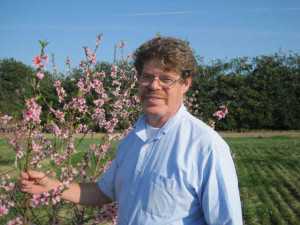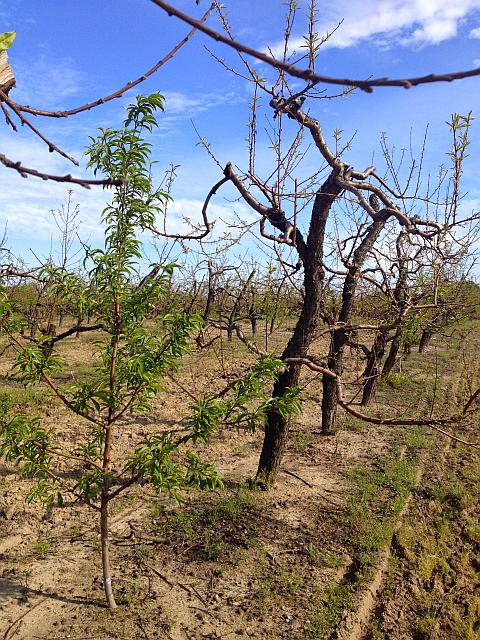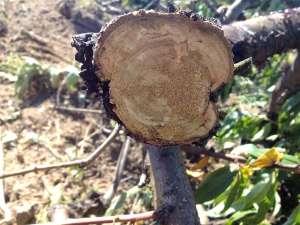How To Decipher Cold Weather Effects on Peaches
 When temperatures drop below normal in peach growing regions, damage is expected, but the type of damage seen may be puzzling until the most important factors are identified. Each freeze event is unique but here are some common trends.
When temperatures drop below normal in peach growing regions, damage is expected, but the type of damage seen may be puzzling until the most important factors are identified. Each freeze event is unique but here are some common trends.
Thinning Old Cows Out Of The Herd
The impact of midwinter low temperatures on peach trees depends on the history of the orchard as well as the low temperatures. For example, growers in southern Michigan were surprised by significant tree mortality in the spring of 2014 following lows of -13°F to -17°F in January in some sites.
Close examination showed damage was worst on older trees, with replants in the same orchard showing much less damage (Figure 1).

Figure 1. Decline of older peach trees and survival of young replant following low temperatures in winter of 2013-14 in southern Michigan. (Photo credit: Bill Shane)
Closer examination showed those trees coming into the winter with poor trunks were the ones that looked far worse (Figure 2). Upon reflection, it was recalled that many years had passed since a low temperature event had culled the weaker trees in the area orchards.
The last significant midwinter cold event during the midwinter for this region was back in the winter of 1993-94 when many trees were injured, removed, and replaced. Mild conditions in the 20 years since that time had allowed many older weak trees to survive.
It’s A Matter Of Timing
Some varieties are simply hardier than others, as is learned when a mild climate variety such as O’Henry is grown where midwinter temperatures approach -10°F. But sometimes the situation is more complicated than this.
A variety with generally good fruit bud hardiness one year may look poor in another. Reasons for variety differences from year to year can be due to slight differences in growth stage development.
Peach fruit buds can be roughly classified as showy and non-showy (Figure 3). Showy types with large pretty flowers, such as Loring, tend to bloom a few days before their plain-looking non-showy cousins, such as Redhaven and Glohaven.
Showy types may experience more cold damage to fruit buds at the very first stages of bloom because non-showy fruit buds are not yet opened. However, showy flower buds can have an advantage later in bloom. Peach flowers, slightly before full bloom, are slightly less cold tolerant than open flowers that have been pollinated.

Figure 2. Cross section of peach scaffold showing general poor condition developed over many years. (Photo credit: Bill Shane)
Some peach varieties are more reliably cold hardy because they bloom consistently later than other varieties. Good examples of these are the yellow-flesh varieties Contender and Reliance, and the white-flesh peach China Pearl. These are so-called high chill hour varieties, meaning these varieties need to experience a relatively high number of hours in the 38°F to 42°F range during the winter before they are able to bloom in the spring.
Another hardiness strategy is presented by the variety Redhaven. Redhaven has an extended bloom, in that fruit buds at the distal end of the branch open before those on the basal region. In some years the basal fruit buds of Redhaven can produce at least a partial crop even when the distal end has been damaged by spring frost.

Figure 3. Showy (left) peach varieties generally bloom sooner than non-showy (right) types. (Photo credits: Bill Shane)
More Is Better, Sometimes
Another strategy for fruit bud survival is to have many flowers per tree — this is an attribute of varieties such as Harcrest, Saturn, Reliance, and Starfire. The downside for the abundant bud variety types is the high cost of fruit thinning in a year when freeze damage is not a problem.
Growers farming in areas with more frost problems tend to opt for varieties with abundant fruit buds — mechanical blossom thinners are particularly helpful for these varieties. Mechanical bloom thinners are also good for varieties such as the pan tao peach Saturn that have fruit that cling very tightly and are a nuisance to hand thin.
The Complex Realm Of Rootstocks And Hardiness
Rootstock plays a role in peach hardiness, but the effect of a particular rootstock on tree health, hardiness, and productivity is complex. Quality of the tree planted and site conditions tend to be more important than differences among the common seedling-type rootstocks, such as Bailey, Lovell, Tennessee Natural, and Halford, used in cooler, humid growing regions.
However, we can see differences in rootstock vigor, for example, greater vigor of Lovell versus Bailey, can affect how quickly trees settle down into dormancy in the fall. In those years when autumn temperatures drop quickly, trees that have not settled down into dormancy will show young twig discoloration, limb dieback, bark cambium discoloration, and long-term problems.










